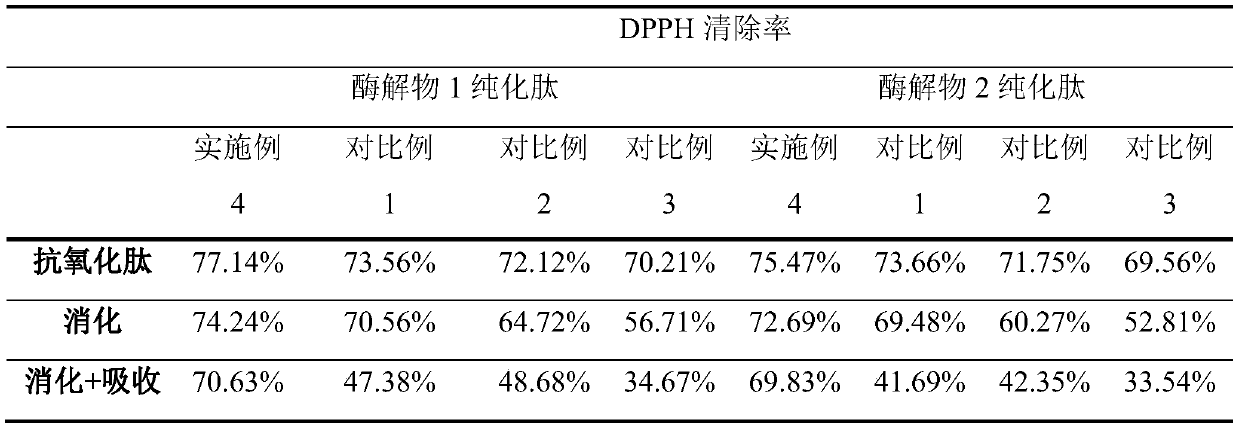Directional active peptide preparation method based on Caco-2 cell model
A technology of active peptides and cells, which is applied in the field of directional preparation of active peptides, can solve the problems of loss of activity, achieve wide application prospects, improve digestion resistance and easy absorption, and overcome the effects of digestive system damage or inability to be absorbed and utilized by the human body
- Summary
- Abstract
- Description
- Claims
- Application Information
AI Technical Summary
Problems solved by technology
Method used
Image
Examples
Embodiment 1
[0023] Embodiment 1: Preparation of rice protein hydrolyzate
[0024] Disperse the rice protein in water, the ratio of solid to liquid is 1:20, stir and mix well, adjust the pH value of the above rice protein dispersion to 8.0 with 1mol / L NaOH solution, add alkaline protease according to the ratio of 8000U / g, control the temperature as 50°C, enzymatic hydrolysis for 2 hours, after the end of the enzymatic hydrolysis, inactivate the enzyme in a 90°C water bath for 20 minutes, after cooling, centrifuge, take the supernatant and freeze-dry to obtain rice protein hydrolyzate 1.
[0025] Disperse the rice protein in water, the ratio of solid to liquid is 1:20, stir and mix well, adjust the pH value of the above rice protein dispersion to 7.5 with 1mol / L NaOH solution, add neutral protease according to the ratio of 7000U / g, control the temperature as 55°C, enzymatic hydrolysis for 2 hours, after the end of the enzymatic hydrolysis, inactivate the enzyme in a 90°C water bath for 20 m...
Embodiment 2
[0026] Example 2: In vitro simulation of gastrointestinal digestion
[0027] Prepare the rice protein hydrolyzate 1 in Example 1 into a 5% solution, add HCl solution to adjust the pH to 1.3, add pepsin, react at 37°C for 1 hour, and simulate gastric juice digestion; then digest the simulated gastric juice with NaOH Adjust the pH to 7.0, add trypsin, and react at 37°C for 2 hours to simulate intestinal juice digestion. After the in vitro simulated gastrointestinal digestion, the enzyme was inactivated in a water bath at 90°C for 20 minutes, centrifuged, and freeze-dried to obtain the anti-digestion active peptide mixture 1.
[0028] The rice protein hydrolyzate 2 in Example 1 was subjected to in vitro simulated gastrointestinal digestion by the same method, and the enzyme was inactivated, centrifuged, and freeze-dried to obtain the anti-digestion active peptide mixture 2.
Embodiment 3
[0029] Example 3: Caco-2 cell model simulates intestinal absorption
[0030] Caco-2 cells were inoculated into transwell chambers at a seeding density of 400,000 cells / well, the culture medium was changed three times a week, and cultured continuously for 2 weeks to make them grow into a complete cell layer. The active peptide mixture 1 obtained in Example 2 was made into a 1 mg / mL solution with PBS (pH 7.2) buffer, and 0.3 mL of the active peptide mixture solution prepared by PBS buffer was added to the upper chamber of the transwell chamber, and 1.2 mL of the active peptide mixture was added to the lower chamber. mL PBS buffer. After 2 hours of action, the substances in the lower chamber were collected and set aside.
[0031] The anti-digestion active peptide mixture 2 obtained in Example 2 was subjected to Caco-2 cell model to simulate intestinal absorption in the same way.
PUM
 Login to View More
Login to View More Abstract
Description
Claims
Application Information
 Login to View More
Login to View More - R&D
- Intellectual Property
- Life Sciences
- Materials
- Tech Scout
- Unparalleled Data Quality
- Higher Quality Content
- 60% Fewer Hallucinations
Browse by: Latest US Patents, China's latest patents, Technical Efficacy Thesaurus, Application Domain, Technology Topic, Popular Technical Reports.
© 2025 PatSnap. All rights reserved.Legal|Privacy policy|Modern Slavery Act Transparency Statement|Sitemap|About US| Contact US: help@patsnap.com

